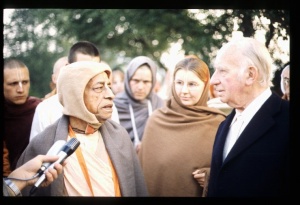CC Madhya 21.106 (1975)

A.C. Bhaktivedanta Swami Prabhupada
Below is the 1996 edition text, ready to be substituted with the 1975 one using the compile form.
TEXT 106
- brahmāṇḍopari paravyoma, tāhāṅ ye svarūpa-gaṇa,
- tāṅ-sabāra bale hare mana
- pati-vratā-śiromaṇi, yāṅre kahe veda-vāṇī,
- ākarṣaye sei lakṣmī-gaṇa
SYNONYMS
brahmāṇḍa-upari—above all the universes; para-vyoma—the spiritual sky; tāhāṅ—there; ye—all those; svarūpa-gaṇa—transcendental personal expansions; tāṅ-sabāra—of all of Them; bale—by force; hare mana—it enchants the minds; pati-vratā—of those who are chaste and devoted to the husband; śiromaṇi—topmost; yāṅre—unto whom; kahe—describe; veda-vāṇī—hymns of the Vedas; ākarṣaye—it attracts; sei—those; lakṣmī-gaṇa—all the goddesses of fortune.
TRANSLATION
“The beauty of Kṛṣṇa’s body is so attractive that it attracts not only the demigods and other living entities within this material world but the personalities of the spiritual sky as well, including the Nārāyaṇas, who are expansions of Kṛṣṇa’s personality. The minds of the Nārāyaṇas are thus attracted by the beauty of Kṛṣṇa’s body. In addition, the goddesses of fortune [Lakṣmīs], who are the wives of the Nārāyaṇas and are the women described in the Vedas as most chaste, are also attracted by the wonderful beauty of Kṛṣṇa.